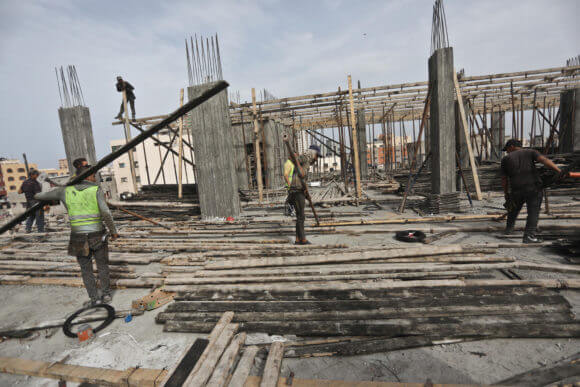On May 1, as workers across the world take a day off to observe May Day, the buzz of blacksmiths and carpenters fill the upper floors of a new building under construction at al-Shifa hospital in Gaza City. Porters deliver bags of cement. All the workers seem unaware of the occasion.
At 6:30 a.m. on the fifth floor of a new maternity ward under construction, Aref Jendia, 43, is setting up iron pillars along with 17 employees. Their breakfast, an untouched spicy bean dish and hard-boiled eggs, seems forgotten.

“Oh! You are right,” said Jendia, who has 25-year of experience in the construction business, as I remind him about their long-awaited meal. However, “I think they are so happy from my phone call last night that we could resume work instead of [taking off for the] declared public holiday. Each are waiting for their $13 wage at the end of the day.”
One worker said he is “so lucky” to have an extra day of income.
“We were like wealthy Singaporeans before the current Egyptian President Abdel Fattah el-Sisi led the military’s overthrow of elected president Mohammed Morsi in 2013,” he said, “At that time, Palestinians were able to smuggle tons of cement and building materials daily into Gaza through smuggling tunnels, which function as lifelines to Gaza’s 2.2 million inhabitants.”
In 2013 the Egyptian military began closing underground tunnels between the Sinai and Gaza used to smuggle consumer goods, livestock and weapons into the besieged strip. From 2007 to 2013 the UN found there were up to 1,532 tunnels, but the Egyptian military destroyed most once Sisi assumed power and changed Egypt’s policies towards Gaza.

Another construction worker, Fadi Ayman, 34, said salaries also fell at that time. Ayman is the breadwinner for his family of four children and another eight-person family.
“In 2013, we were paid double compared to today’s wage, when smuggling materials and building projects were nonstop,” he said.
Now construction jobs are scarce. Yet Ayman has been working on the new wing of the hospital for the last week. The project needs him to work on May 1, when children are off of school in Gaza. As a result Ayman has found himself in rare situation amid Gaza’s high unemployment rate of having to be “a good procrastinator.” His kids want him to take them on a picnic today, but he has to go to work.


Unemployment in Gaza jumped from 44 percent in 2017 to 52 percent in 2018, compared to 19 percent in 2017 in the West Bank and 18 percent the following year, according to the Palestinian Central Bureau of Statistics.
Part of why building is stalled in Gaza is because construction materials are difficult to import and require lengthy waits from approved vendors, and coordination with on-site monitors. After the 2014 war the United Nations mediated a deal between Israel and the Palestinian government called the Gaza Reconstruction Mechanism, or GRM, that overhauled the entry of materials like concrete, glass and rebar. The stringent regulations outlined by GRM ensures that dual-use materials are not diverted for illegitimate use in militant activities.
Yet, housing starts and industrial building was already in decline by the time of the 2014 war and the GRM. When Israel began its blockade on the Gaza Strip in 2007, aside from denying basic rights of movement to Palestinians in Gaza, the siege drastically reduced imports to Gaza. Unemployment started to spike, and the standard of the living dropped.
One contractor said, “Working in building business was so feasible and cost-effective before the siege, but today, a worker would be so lucky to going home with a fresh chicken and a mallow soup for their family’s lunch. I cannot pay for more.”
The contractor said the average day rate in Israel is five times what construction workers in Gaza make, around $66. While Palestinian in the West Bank have an opportunity to apply for work permits in Israel or the settlements or sneak across the Green Line, workers in Gaza are prohibited.
The impacts of the siege have left around 1.3 million Palestinians in Gaza, around 68 percent of the population “food insecure,” according to a 2018 United Nations study. Nearly the same amount of people receive some sort of food aid.

“As long life in Gaza is politicized, then the loaf of bread will be,” said Mahmoud Hassan, 24, “everything became politicized since the blockade and the infighting between Hamas and Fatah.” Hassan has been engaged for the last 20 months and said he is unable to pay a dowry or afford to marry her.
Moving to an industrial zone in Shejaiya, east of Gaza City, Maged al-Dali, 27, an auto painter has steady work, but the pay is extremely low.
“If you work, you are lucky, if not, then you starve,” al-Dali says.
Al-Dali’s earnings supports himself and six others. He said he “is obligated” to work 12-hour days, sometimes until midnight, for only $7 per day.
“Working is better than sleeping, at least my family can remember taste of chicken,” a forlorn al-Dali said.
When asked if he would want to work in Israel, al-Dali responded, “Are you kidding? We would close the workshop forever, would only need to work over there for a year and would be back home in time to celebrate May Day next year.”



